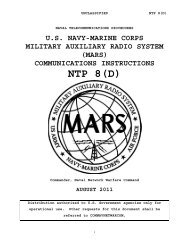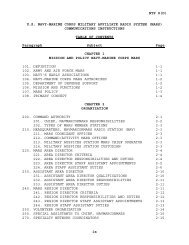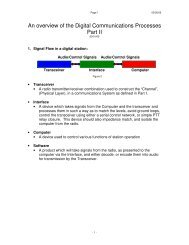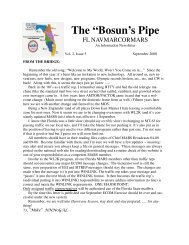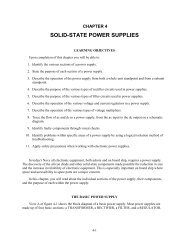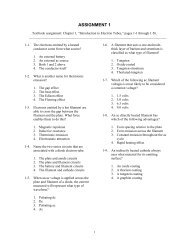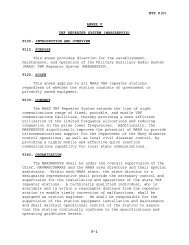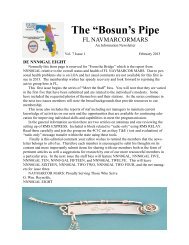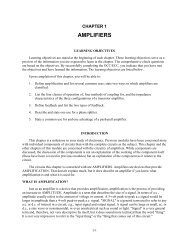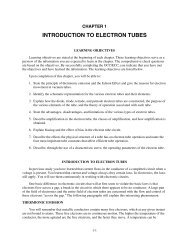Create successful ePaper yourself
Turn your PDF publications into a flip-book with our unique Google optimized e-Paper software.
The movable coil is wrapped around the aluminum frame of the galvanometer. The coil is suspendedbetween the poles of the magnet by means of thin, flat ribbons of phosphor bronze. These ribbons providea conduction path for the current between the circuit being tested and the movable coil. The ribbons allowthe coil to twist in response to the interaction of the applied current through the coil and the magneticfield of the permanent magnet. They also provide the restoring force for the coil. Basically, the restoringforce is that force necessary to return the movable frame to its resting position after a reading. Theribbons restrain or provide a counterforce to the magnetic force acting on the coil. When the driving forceof the coil current is removed, the restoring force provided by the ribbons returns the coil to its zeroposition.Q-2. What physical component of a galvanometer provides the restoring force for the coil?To determine the amount of current flow, we must have a means to indicate the amount of coilrotation. Either of two methods may be used: (1) the POINTER arrangement or (2) the LIGHT ANDMIRROR arrangement.Q-3. In a galvanometer, what two methods are used to indicate the amount of coil rotation?In the pointer arrangement, one end of the pointer is mechanically connected to the rotating coil; asthe coil moves, the pointer also moves. The other end of the pointer moves across a graduated scale andindicates the amount of current flow. The overall simplicity of this arrangement is its main advantage.However, a disadvantage of this arrangement is that it introduces a mechanical coil balancing problem,especially if the pointer is long.Q-4. What is the primary disadvantage of the pointer arrangement for indicating coil rotation?In the light and mirror arrangement, the use of a mirror and a beam of light simplifies the problem ofcoil balance. When this arrangement is used to measure the turning of the coil, a small mirror is mountedon the supporting ribbon, as shown in figure 3-1. An internal light source is directed to the mirror andthen reflected to the scale of the meter. As the movable coil turns, so does the mirror. This causes the lightreflection to move across the graduated scale of the meter. The movement of the reflection is proportionalto the movement of the coil; therefore, the intensity of the current being measured by the meter isaccurately indicated.If the beam of light and mirror arrangement is used, the beam of light is swept to the right or leftacross a translucent screen (scale). The translucent screen is divided uniformly with the zero readinglocated at center scale. If the pointer arrangement is used, the pointer is moved in a horizontal plane to theright or left across a scale that is divided uniformly with the zero reading at the center. The direction inwhich the beam of light or the pointer moves depends on the direction (polarity) of current through thecoil.D’Arsonval Meter MovementMost dc instruments use meters based on some form of the D’Arsonval meter movement. InD’Arsonval-type meters, the length of the conductor and the strength of the field between the poles of themagnet are fixed. Therefore, any change in current causes a proportional change in the force acting on thecoil. Figure 3-2 is a simplified diagram showing the principle of the D’Arsonval movement.3-3




